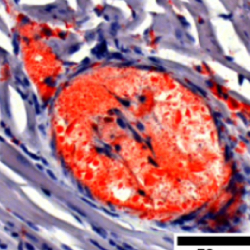
The high density lipoprotein (HDL) receptor scavenger receptor class B type 1 (SR-B1) is a high affinity, cell-surface receptor found on a variety of cell types, including hepatocytes, macrophages and cardiomyocytes. It mediates the bidirectional movement of lipids, including cholesterol, between cells and lipoproteins. At the arterial wall, SR-B1 mediates cholesterol efflux and signaling pathways in macrophages and endothelial cells, and at the liver hepatocytes, SR-B1 mediates the selective uptake of HDL-cholesterol by hepatocytes. LDL receptor knockout mice develop atherosclerosis when fed high fat/high cholesterol diets, while apoE knockout mice spontaneously develop atherosclerosis in their aortas including vessels branching from their aortas. When SR-B1 is also knocked out in these mice (SR-B1/LDLR double knockout or SR-B1/apoE double knockout mice), they rapidly develop either high fat/high cholesterol diet-induced or spontaneous atherosclerosis in their coronary arteries in addition to increased plaque development in the aortic sinus. Extensive atherosclerotic development in the coronary arteries leads to myocardial infarction in the mice. Our findings suggest that SR-B1 is key to protection against coronary artery atherosclerosis.
In the Trigatti Lab, we are investigating and characterizing components of molecular mechanisms involving SR-B1 that regulate the development of atherosclerosis. As well, we are using SR-B1 knockout mice as models to study factors affecting coronary artery atherosclerosis.
